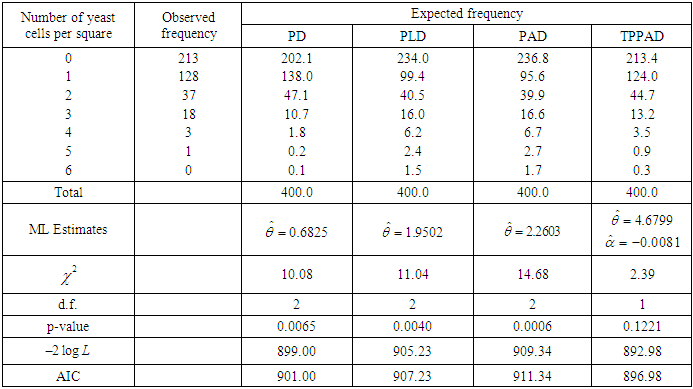-
Paper Information
- Paper Submission
-
Journal Information
- About This Journal
- Editorial Board
- Current Issue
- Archive
- Author Guidelines
- Contact Us
International Journal of Probability and Statistics
p-ISSN: 2168-4871 e-ISSN: 2168-4863
2018; 7(4): 114-123
doi:10.5923/j.ijps.20180704.03

A Two-Parameter Poisson-Akash Distribution with Properties and Applications
Rama Shanker1, Kamlesh Kumar Shukla1, Tekie Asehun Leonida2
1Department of Statistics, College of Science, Eritrea Institute of Technology, Asmara, Eritrea
2Department of Applied Mathematics, University of Twente, The Netherlands
Correspondence to: Rama Shanker, Department of Statistics, College of Science, Eritrea Institute of Technology, Asmara, Eritrea.
| Email: |  |
Copyright © 2018 The Author(s). Published by Scientific & Academic Publishing.
This work is licensed under the Creative Commons Attribution International License (CC BY).
http://creativecommons.org/licenses/by/4.0/

This paper proposes a two-parameter Poisson- Akash distribution which includes Poisson-Akash distribution as a special case. Its moments and moments based measures have been derived and studied. Statistical properties including hazard rate function, unimodality and generating functions have been discussed. Method of moments and the method of maximum likelihood have been discussed for estimating the parameters of the distribution. Finally, applications of the proposed distribution have been explained through two count datasets from biological sciences and compared with other discrete distributions.
Keywords: Two-parameter Akash distribution, Poisson- Akash distribution, Compounding, Moments, Skewness, Kurtosis, Maximum likelihood estimation, Applications
Cite this paper: Rama Shanker, Kamlesh Kumar Shukla, Tekie Asehun Leonida, A Two-Parameter Poisson-Akash Distribution with Properties and Applications, International Journal of Probability and Statistics , Vol. 7 No. 4, 2018, pp. 114-123. doi: 10.5923/j.ijps.20180704.03.
Article Outline
1. Introduction
- The modeling and statistical analysis of count data are crucial in almost every fields of knowledge including biological science, insurance, medical science, and finance, some amongst others. Count data are generated by various phenomena such as the number of insurance claimants in insurance industry, number of yeast cells in biological science, number of chromosomes in genetics, etc. It has been observed that, in general, count data follows under-dispersion (variance < mean), equi-dispersion (variance = mean) or over-dispersion (variance > mean). The over-dispersion of count data have been addressed using mixed Poisson distributions by different researchers including Raghavachari et al (1997), Karlis and Xekalaki (2005), Panjeer (2006), are some among others. Mixed Poisson distributions arise when the parameter of the Poisson distribution is a random variable having some specified distributions. The distribution of the parameter of the Poisson distribution is known as mixing distribution. It has been observed that the general characteristics of the mixed Poisson distribution follow some characteristics of its mixing distributions. In distribution theory, various mixed Poisson distributions have been derived by selecting a proper mixing distribution. The classical negative binomial distribution (NBD) derived by Greenwood and Yule (1920) is the mixed Poisson distribution where the mean of the Poisson random variable is distributed as a gamma random variable. The NBD has been used to model over-dispersed count data. However, the NBD may not be appropriate for some over-dispersed count data due to its theoretical or applied point of view. Other mixed Poisson distributions arise from the choice of alternative mixing distributions. For example, the Poisson-Lindley distribution, introduced by Sankaran (1970), is a Poisson mixture of Lindley (1958) distribution. The Poisson-Akash distribution, introduced by Shanker (2017), is a Poisson mixture of Akash distribution suggested by Shanker (2015). It has been observed by Karlis and Xekalaki (2005) that there are naturally situations where a good fit is not obtainable with a particular mixed Poisson distribution in case of over-dispersed count data. This shows that there is a need for new mixed Poisson distribution which gives a better fit as compared with the existing mixed Poisson distributions. Shanker (2017) proposed the discrete Poisson- Akash distribution (PAD) to model count data defined by its probability mass function (pmf)
 | (1.1) |
 follows Akash distribution introduced by Shanker (2015) and defined by its probability density function (pdf)
follows Akash distribution introduced by Shanker (2015) and defined by its probability density function (pdf) | (1.2) |
 and gamma
and gamma  distributions. Shanker (2015) discussed statistical properties including moments based coefficients, hazard rate function, mean residual life function, mean deviations, stochastic ordering, Renyi entropy measure, order statistics, Bonferroni and Lorenz curves, stress- strength reliability, along with estimation of parameter and applications to model lifetime data from biomedical science and engineering. The first four moments about origin and the variance of PAD (1.1) obtained by Shanker (2017) are given by
distributions. Shanker (2015) discussed statistical properties including moments based coefficients, hazard rate function, mean residual life function, mean deviations, stochastic ordering, Renyi entropy measure, order statistics, Bonferroni and Lorenz curves, stress- strength reliability, along with estimation of parameter and applications to model lifetime data from biomedical science and engineering. The first four moments about origin and the variance of PAD (1.1) obtained by Shanker (2017) are given by 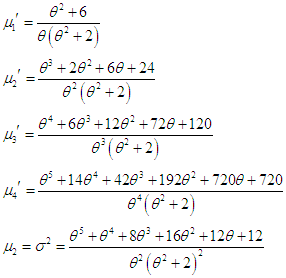 Shanker and Shukla (2017) proposed a two-parameter Akash distribution (TPAD) having parameters
Shanker and Shukla (2017) proposed a two-parameter Akash distribution (TPAD) having parameters  and
and  and defined by its pdf
and defined by its pdf  | (1.3) |
 TPAD (1.3) reduces to Akash distribution (1.2). The main purpose of this paper is to propose a two-parameter Poisson- Akash distribution, a Poisson mixture of two-parameter Akash distribution suggested by Shanker and Shukla (2017). Its moments based measures including coefficients of variation, skewness, kurtosis and index of dispersion have been derived and their behaviors have been discussed graphically. Its statistical properties including hazard rate function, unimodality and generating functions have been studied. The estimation of parameters has been discussed using method of moments and the method maximum likelihood. Applications and goodness of fit of the distribution has also been discussed through two examples of observed real count datasets from biological sciences and the fit has been compared with other discrete distributions.
TPAD (1.3) reduces to Akash distribution (1.2). The main purpose of this paper is to propose a two-parameter Poisson- Akash distribution, a Poisson mixture of two-parameter Akash distribution suggested by Shanker and Shukla (2017). Its moments based measures including coefficients of variation, skewness, kurtosis and index of dispersion have been derived and their behaviors have been discussed graphically. Its statistical properties including hazard rate function, unimodality and generating functions have been studied. The estimation of parameters has been discussed using method of moments and the method maximum likelihood. Applications and goodness of fit of the distribution has also been discussed through two examples of observed real count datasets from biological sciences and the fit has been compared with other discrete distributions. 2. A Two-Parameter Poisson-Akash Distribution
- Assuming that the parameter
 of the Poisson distribution follows TPAD (1.3), the Poisson mixture of TPAD can be obtained as
of the Poisson distribution follows TPAD (1.3), the Poisson mixture of TPAD can be obtained as | (2.1) |
 | (2.2) |
 The nature and behavior of TPPAD for varying values of the parameters
The nature and behavior of TPPAD for varying values of the parameters  and
and  have been explained graphically in figure 1.
have been explained graphically in figure 1.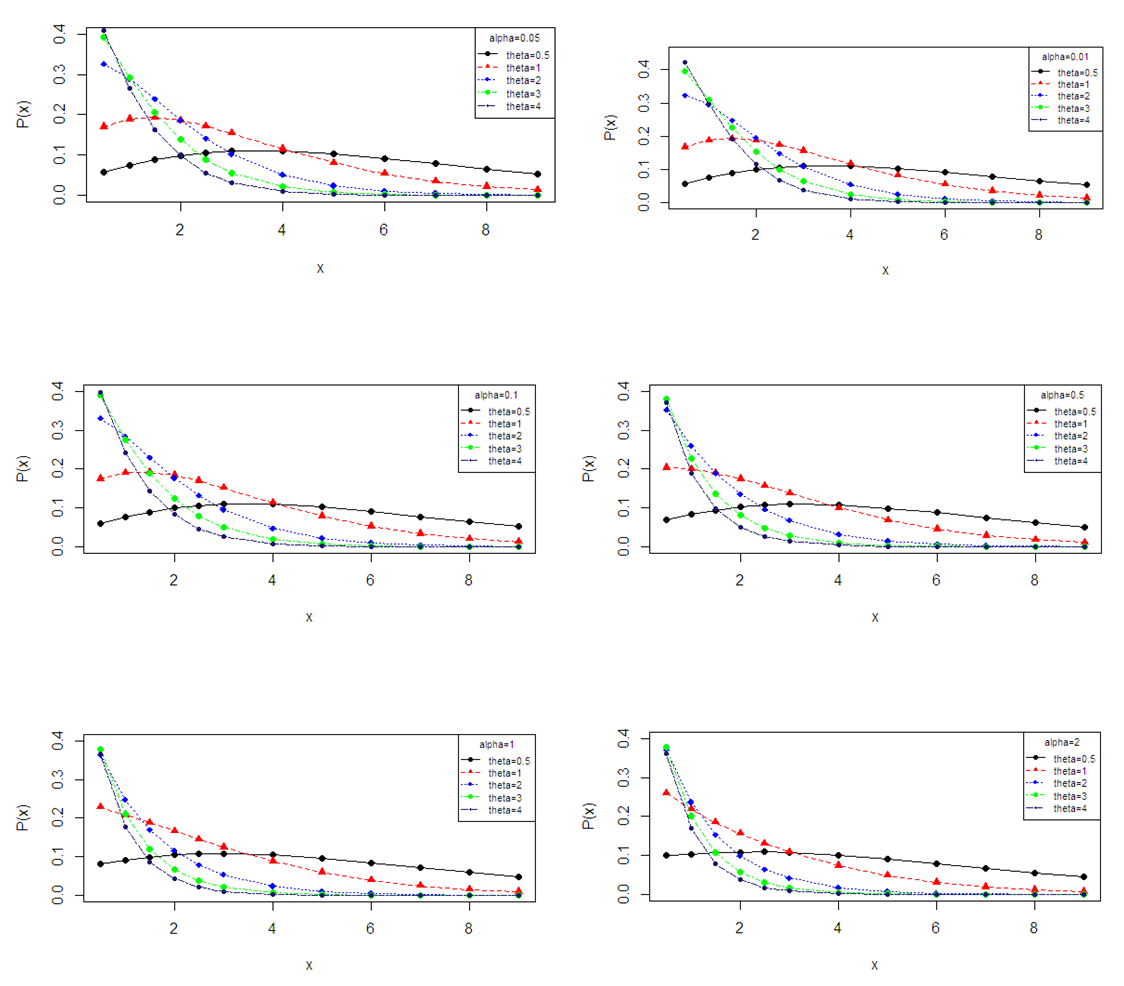 | Figure 1. Probability mass function plot of TPPAD for varying values of parameters  |
3. Statistical Constants
- In this section factorial moments, raw moments, central moments and moments based statistical measures including coefficient of variation, skewness, kurtosis and index of dispersion of TPPLD has been obtained.
3.1. Factorial Moments
- Using (2.1), the th factorial moment about origin of the TPPAD (2.2) can be obtained as
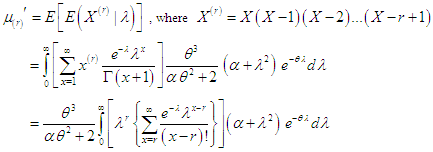 Assuming
Assuming  , we get
, we get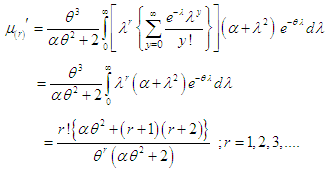 | (3.1.1) |
 in (3.1.1), the first four factorial moments about origin of TPPAD (2.2) can be obtained
in (3.1.1), the first four factorial moments about origin of TPPAD (2.2) can be obtained 
3.2. Raw Moments (Moments about Origin)
- Using the relationship between factorial moments about origin and the raw moments, the first four raw moments of TPPAD (2.2) can be obtained as
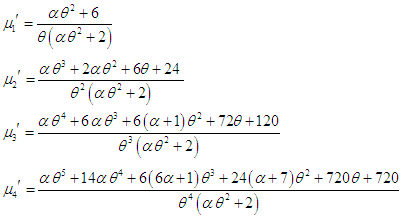
3.3. Central Moments (Moments about Mean)
- Using the relationship
 between central moments and the raw moments, the central moments of the TPPAD (2.2) can be obtained as
between central moments and the raw moments, the central moments of the TPPAD (2.2) can be obtained as
3.4. Coefficients of Variation, Skewness, Kurtosis and Index of Dispersion
- The coefficient of variation
 coefficient of Skewness
coefficient of Skewness  coefficient of Kurtosis
coefficient of Kurtosis  and index of dispersion
and index of dispersion  of the TPPAD (2.2) are thus obtained as
of the TPPAD (2.2) are thus obtained as  Now from the index of dispersion it is obvious that if
Now from the index of dispersion it is obvious that if  and
and  then
then  (over dispersion); if
(over dispersion); if  and
and  , then
, then  (under dispersion) and if
(under dispersion) and if  and
and  , then
, then  (equi dispersion). Nature and behavior of coefficient of variation, coefficient of skewness, coefficient of kurtosis and index of dispersion of TPPAD for varying values of parameters
(equi dispersion). Nature and behavior of coefficient of variation, coefficient of skewness, coefficient of kurtosis and index of dispersion of TPPAD for varying values of parameters  and
and  have been shown graphically in figure 2.
have been shown graphically in figure 2. | Figure 2. Nature and behavior of coefficient of variation, coefficient of skewness, coefficient of kurtosis and index of dispersion of TPPAD for varying values of parameters  |
4. Statistical Properties
- In this section the unimodality, increasing hazard rate, probability generating function and the moment generating function of TPPLD has been discussed.
4.1. Increasing Hazard Rate and Unimodality
- We have
 It can be easily verified that this is a decreasing function in
It can be easily verified that this is a decreasing function in  and hence
and hence  is log-concave. Now using the results of relationship between log-concavity, unimodality and increasing hazard rate (IHR) of discrete distributions given in Grandell (1997), it can concluded that TPPAD (2.2) has an increasing hazard rate and is unimodal.
is log-concave. Now using the results of relationship between log-concavity, unimodality and increasing hazard rate (IHR) of discrete distributions given in Grandell (1997), it can concluded that TPPAD (2.2) has an increasing hazard rate and is unimodal.4.2. Generating Functions
- The probability generating function of TPPAD can be obtained as
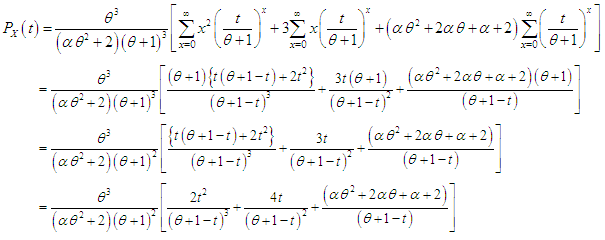 The moment generating function of TPPAD is thus given by
The moment generating function of TPPAD is thus given by
5. Estimation of Parameters
- In this section the estimation of parameters of TPPLD using the method of moments and the method of maximum likelihood has been discussed.
5.1. Method of Moments Estimation of Parameters
- Since TPPAD has two parameters to be estimated, taking the first two moments about origin, we have
 Assuming
Assuming  , we get
, we get This gives a quadratic equation in
This gives a quadratic equation in  as
as Replacing the first population moment about origin and the second population moment about origin with their respective sample moments, an estimate of
Replacing the first population moment about origin and the second population moment about origin with their respective sample moments, an estimate of  can be obtained and substituting the value of in the above equation, an estimate of
can be obtained and substituting the value of in the above equation, an estimate of  can be obtained. Again, replacing the population mean with the corresponding sample mean and taking
can be obtained. Again, replacing the population mean with the corresponding sample mean and taking  in
in  , we get
, we get  This gives the method of moments estimate (MOME)
This gives the method of moments estimate (MOME)  of parameter
of parameter  as
as  Thus the MOME
Thus the MOME  of parameter
of parameter  is given by
is given by 
5.2. Maximum Likelihood Estimation of Parameters
- Suppose
 be a random sample of size
be a random sample of size  from the TPPAD (2.2) and let
from the TPPAD (2.2) and let  be the observed frequency in the sample corresponding to
be the observed frequency in the sample corresponding to  such that
such that  where
where  is the largest observed value having non-zero frequency. The log- likelihood function of TPPAD (2.2) can be given by
is the largest observed value having non-zero frequency. The log- likelihood function of TPPAD (2.2) can be given by The maximum likelihood estimates
The maximum likelihood estimates  of parameters
of parameters  of TPPAD (2.2) is the solutions of the following log- likelihood equations
of TPPAD (2.2) is the solutions of the following log- likelihood equations where
where  is the sample mean. These two log likelihood equations do not seem to be solved directly because they are not in closed forms. These two log-likelihood equations can be solved iteratively using R-software till sufficiently close estimates of
is the sample mean. These two log likelihood equations do not seem to be solved directly because they are not in closed forms. These two log-likelihood equations can be solved iteratively using R-software till sufficiently close estimates of  and
and  are obtained.
are obtained.6. Applications
- The TPPAD has been fitted to two count datasets from biological sciences to test its goodness of fit over Poisson distribution (PD), Poisson-Lindley distribution (PLD) and Poisson-Akash distribution (PAD) using maximum likelihood estimates (MLE’s) of parameters. The first dataset is the number of Student’s historic data on Haemocytometer counts of yeast cells available in Gosset (1908) and the second data set is the number of European corn- borer of Mc. Guire et al (1957). The fitted plots of distributions for datasets in tables 1 and 2 are presented in figure 3. Since the expected frequencies given by TPPAD are more closure to the original frequencies than the expected frequencies given by PD, PLD, and PAD, it is clear from the goodness of fit of TPPAD and from the fitted plots of distributions that TPPAD gives much closer fit than PD, PLD, and PAD and hence it can be considered as an important distribution in ecology.
|
|
 | Figure 3. Fitted plots of distributions for datasets 1 and 2 |
7. Conclusions
- A two-parameter Poisson-Akash distribution (TPPAD) which includes one parameter Poisson-Akash distribution has been proposed. Its moments and moments based statistical constants have been derived and studied. Some statistical properties have been discussed. Method of moments and the method of maximum likelihood have been discussed for estimating parameters of the distribution. Finally, applications of the proposed distribution have been explained with two count datasets from biological sciences and fit has been found quite satisfactory over other discrete distributions including PD, PLD and PAD.
ACKNOWLEDGEMENTS
- Authors are grateful to the editor in chief of the journal and the anonymous reviewer for their fruitful comments.
 Abstract
Abstract Reference
Reference Full-Text PDF
Full-Text PDF Full-text HTML
Full-text HTML